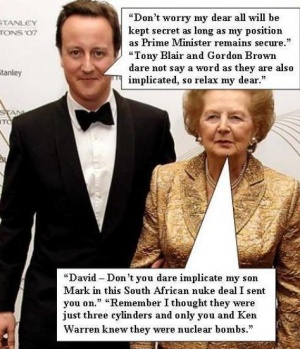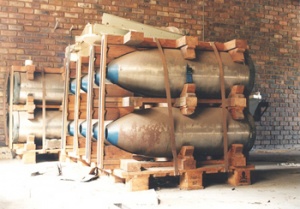Difference between revisions of "South Africa/Nuclear weapons"
(Expanding) |
m (Robin moved page South Africa's nuclear weapons to South Africa/Nuclear weapons: Subpage is logical) |
(No difference)
| |
Revision as of 17:23, 12 February 2015

South Africa's nuclear weapons were developed in the 1970s and 1980s in co-operation with Israel, claimed David Albright in the Bulletin of the Atomic Scientists and Chris McGreal in The Guardian.[1][2][3] Such co-operation is in clear breach of United Nations Security Council Resolution 418 of 4 November 1977 which introduced a mandatory arms embargo against South Africa, and required all states to refrain from "any co-operation with South Africa in the manufacture and development of nuclear weapons".[4][5][6]
David Albright also reported that although President P W Botha had limited the number of South Africa's nuclear weapons to seven in 1985, it was estimated that those gun-type devices had enough Highly Enriched Uranium (HEU) to produce as many as fourteen nuclear bombs.[7]
In what has been described as a sanctions-busting trip, a youthful David Cameron visited South Africa in 1989 accompanied by Conservative MP, Sir Kenneth Warren, and nuclear weapons inspector, Dr David Kelly who in several earlier visits had been given access to South Africa's nuclear weapons research facility at Pelindaba, near Pretoria.[8] The purpose of David Cameron's trip was to arrange for three of South Africa's nuclear weapons to be shipped to Oman, where the nukes would be stored in case they were required in Iraq. The remaining six nukes were destined to travel from South Africa to Chicago in the US. The next phase of the operation was that, once the weapons had left South African soil, the British Government would reimburse the South African firm Armscor and the British firm Astra through the middle man John Bredenkamp. In order to keep this out of Parliament and out of the public domain, Margaret Thatcher was asked to sign off these weapons under a special Urgent Operational Requirement (UOR) describing them as metal cylinders rather than nuclear bombs. This UOR document was signed just before Mrs Thatcher left office in late 1990.[9] It was subsequently revealed that £17.8 million was siphoned from this secret nuclear deal into Conservative Party funds.[10]
On 7 February 2015, the Daily Mail announced that David Cameron had leaked details from the as yet unpublished Iraq Inquiry report which "will be a 'devastating' indictment of the Blair Government".[11]
On 8 February 2015, it was revealed that the Chilcot Inquiry had been tasked specifically with tracking down those responsible for “misplacing” the three South African nukes 25 years ago. Both David Cameron and Dr David Kelly are understood to have been involved in stealing these WMD which eventually became the pretext for the Iraq War.[12]
Vela Incident
In September 1979 a US Vela satellite detected a double flash over the Indian Ocean that was suspected, but never confirmed to be a nuclear test, despite extensive air sampling by Boeing WC-135 Constant Phoenix aircraft of the United States Air Force. If the Vela Incident was a nuclear test, South Africa is one of the countries, possibly in collaboration with Israel, that is suspected of carrying it out. No official confirmation of its being a nuclear test has been made by South Africa, and expert agencies have disagreed on their assessments. In 1997, South African Deputy Foreign Minister Aziz Pahad stated that South Africa had conducted a test, but later retracted his statement as being a report of rumours.[13]
In February 1994 Commodore Dieter Gerhardt, former commander of South Africa's Simon's Town naval base who was later convicted of spying for the USSR, was reported to have said:
| “ | Although I was not directly involved in planning or carrying out the operation, I learned unofficially that the flash was produced by an Israeli-South African test code-named Operation Phoenix. The explosion was clean and was not supposed to be detected. But they were not as smart as they thought, and the weather changed - so the Americans were able to pick it up.[14] | ” |
In 2000, Gerhardt claimed that Israel agreed in 1974 to arm eight Jericho II missiles with "special warheads" for South Africa.[15]
In 2010, The Guardian released South African government documents that it alleged confirmed the existence of Israel's nuclear arsenal, and were associated with an Israeli offer to sell South Africa nuclear weapons in 1975.[16][17] Israel categorically denied these allegations and said that the documents do not indicate any offer for a sale of nuclear weapons. Israeli President Shimon Peres said that The Guardian article was based on "selective interpretation... and not on concrete facts."[18]
Avner Cohen, author of Israel and the Bomb and The Worst-Kept Secret: Israel's Bargain with the Bomb, said:
- "Nothing in the documents suggests there was an actual offer by Israel to sell nuclear weapons to the regime in Pretoria."[19]
Dismantling
South African forces feared the threat of a "domino effect" in favour of communism, represented in southern Africa by Cuban proxy forces in Angola and threatening Namibia. In 1988 South Africa signed the Tripartite Accord with Cuba and Angola, which led to the withdrawal of South African and Cuban troops from Angola and independence for Namibia. The pre-emptive elimination of nuclear weapons was expected to make a significant contribution toward regional stability and peace, and also to help restore South Africa's credibility in regional and international politics.
It was not until 24 March 1993 that President F W de Klerk publicly announced that South Africa had developed its own nuclear weapons, and that the programme had ended in 1989. All of its bombs were said to have been dismantled, and South Africa acceded to the Treaty on the Non-Proliferation of Nuclear Weapons when South African Ambassador to the United States Harry Schwarz signed the treaty in 1991. On 19 August 1994, after completing its inspection, the International Atomic Energy Agency (IAEA) confirmed that one partially completed and six fully completed nuclear weapons had been dismantled. As a result, the IAEA was satisfied that South Africa's nuclear programme had been converted to peaceful applications.[20]
Treaty of Pelindaba
On 5 April 1995, South Africa joined the Nuclear Suppliers Group (NSG) as a full member and went on to play a leading role in the establishment of the African Nuclear Weapon Free Zone Treaty (also referred to as the Treaty of Pelindaba) in 1996, becoming one of the first members in 1997. South Africa also signed the Comprehensive Nuclear Test Ban Treaty in 1996 and ratified it in 1999.[21]
The Treaty of Pelindaba, which came into effect on 15 July 2009 once it had been ratified by 28 countries, required parties not to engage in the research, development, manufacture, stockpiling acquisition, testing, possession, control or stationing of nuclear explosive devices in the territory of parties to the treaty and the dumping of radioactive wastes in the African zone by treaty parties. The African Commission on Nuclear Energy, in order to verify compliance with the treaty, was established and headquartered in South Africa.[22]
| Year | Activity |
|---|---|
| 1950s and 1960s | Scientific work on the feasibility of peaceful nuclear explosives and support to nuclear power production efforts |
| 1969 | Atomic Energy Board forms group to evaluate technical and economic aspects of nuclear explosives |
| 1970 | Atomic Energy Commission (AEC) releases report identifying uses for nuclear explosives |
| 1971 | R&D approval granted for "peaceful use of nuclear explosives" |
| 1973 | AEC prioritises work on a Gun-type fission weapon |
| 1974 | Work on a nuclear device and the Vastrap test site are authorised |
| 1977 | AEC completes bomb assembly for "cold" test |
| 1978 | First Highly Enriched Uranium (HEU) produced; Armscor assumes control of weapons programme |
| 1979 | Vela Incident; First bomb with HEU core produced by AEC |
| 1982 | First deliverable bomb built; work on weapons safety |
| 1985 | Three-phase nuclear strategy reviewed |
| 1987 | First production bomb built; seven produced, with an eighth under construction |
| 1988 | Armscor prepares Vastrap for a nuclear test |
| 1989 | Nuclear weapons dismantled |
| 1991 | Accedes to Nuclear Non-Proliferation Treaty (NPT) |
References
- ↑
{{URL|example.com|optional display text}} - ↑
{{URL|example.com|optional display text}} - ↑ Unknown author. "RSA Nuclear Weapons Program". Federation of American Scientists.Page Module:Citation/CS1/styles.css must have content model "Sanitized CSS" for TemplateStyles (current model is "Scribunto").
- ↑ "UNSCR 418 of 4 November 1977: States should refrain from "any co-operation with South Africa in the manufacture and development of nuclear weapons"". United Nations. Retrieved 15 May 2011.Page Module:Citation/CS1/styles.css must have content model "Sanitized CSS" for TemplateStyles (current model is "Scribunto").
- ↑ "South Africa: Missile". Nuclear Threat Initiative. November 2011.Page Module:Citation/CS1/styles.css must have content model "Sanitized CSS" for TemplateStyles (current model is "Scribunto").
- ↑
{{URL|example.com|optional display text}} - ↑ "South Africa's Secret Nuclear Weapons"
- ↑ "The US and UK lost three nuclear weapons each! Part 3 - What went missing on Prime Minister Thatcher’s Watch?"
- ↑ "The US and UK lost three nuclear weapons each! Part 4 - What went missing on Prime Minister Thatcher’s Watch?"
- ↑ "UK’s Electoral Commission to investigate Friends of Israel Groups"
- ↑ "Chilcot report will be 'devastating' says No 10 as it emerges THIRTY are in the firing line of heavily critical Iraq Inquiry... and Blair's secret letters to Bush to be revealed in full"
- ↑ "The Colour of David Cameron’s Underwear"
- ↑ "Aziz Pahad's statement and retraction discussed here". Nuclearweaponarchive.org. Retrieved 15 May 2011.Page Module:Citation/CS1/styles.css must have content model "Sanitized CSS" for TemplateStyles (current model is "Scribunto").
- ↑ Proliferation: A flash from the past David Albright, The Bulletin of the Atomic Scientists Nov 1997, pp. 15
- ↑ "Tracking Nuclear Proliferation". PBS Newshour. 2 May 2005.Page Module:Citation/CS1/styles.css must have content model "Sanitized CSS" for TemplateStyles (current model is "Scribunto").
- ↑
{{URL|example.com|optional display text}} - ↑
{{URL|example.com|optional display text}} - ↑
{{URL|example.com|optional display text}} - ↑
{{URL|example.com|optional display text}} - ↑ South Africa and the affordable bomb, David Albright, The Bulletin of the Atomic Scientists Jul 1994, pp 37.
- ↑ "African Nuclear Weapons Free Zone Treaty". Department of Foreign Affairs, Republic of South Africa. Retrieved 2006-07-28.Page Module:Citation/CS1/styles.css must have content model "Sanitized CSS" for TemplateStyles (current model is "Scribunto").
- ↑ disarmament.un.org - Pelindaba Treaty - View chronological order by deposit
- ↑ Roy E. Horton, USAF Institute for National Security Studies (1999). Out of (South) Africa: Pretoria's Nuclear Weapons Experience. Dianne Publishing. p. 17.Page Module:Citation/CS1/styles.css must have content model "Sanitized CSS" for TemplateStyles (current model is "Scribunto").
